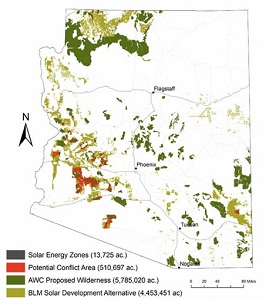Arizona wilderness advocates want a third alternative to BLM’s solar land plan
 Yesterday was the last day for public comment on the Department of Interior’s Bureau of Land Management (BLM) Programmatic Environmental Impact Statement (PEIS). The statement, if approved, would determine how BLM-managed lands in six southwestern states, which include significant tracts of wilderness, are used by solar and renewable energy developers.
Yesterday was the last day for public comment on the Department of Interior’s Bureau of Land Management (BLM) Programmatic Environmental Impact Statement (PEIS). The statement, if approved, would determine how BLM-managed lands in six southwestern states, which include significant tracts of wilderness, are used by solar and renewable energy developers.
As part of the PEIS, BLM offered two options for Arizona, the Solar Development Alternative and the Solar Energy Zones Alternative. The former would open up 4.5 million acres of public lands to solar, wind and other renewable energy projects, and the latter only 13,000 acres for such development.
Neither of the options have pleased environmental advocacy organizations like the Arizona Wilderness Coalition and the Grand Canyon Chapter of the Sierra Club.
But, according to the Sierra Club, if it had to choose one of the BLM’s land-use plans, the group would choose the solar zones plan.
“The Sierra Club and several others prefer the selection of the solar energy zone versus the very broad and not-very-focused selection of land [under the other plan],” said Grand Canyon Chapter Director Sandy Bahr. “The whole idea of doing the PEIS is using lands where there are fewer conflicts—and hopefully no conflicts.”
The larger development alternative proposal would include wildlife corridors, community open-space areas and other lands that could cause conflicts, according to Bahr.
“Why have 4 million acres open when a number of those lands have huge [development] problems. And, BLM said 20,000 acres are needed,” she said.
“We don’t think either is appropriate,” said Matt Skroch, director of the Arizona Wilderness Coalition. “We do think the zones alternative gives more assurance to solar developers and creates less conflict between solar development and other environmental values.”
Both groups said they want to see some of Arizona’s public lands used for solar and renewables.
“We think the zones alternative should be expanded to include additional acres,” Skroch said. They favor a third land-use plan developed at the Arizona BLM office, the Restoration Design Energy Project (RDEP).
“It’s unique because it’s state-specific,” Skroch said.
The plan focuses on lands that have previously been disturbed, lands like farms that are no longer in production.
“The fundamental purpose of the RDEP is to identify areas that are in highly impacted sites for solar development. It’s a perfectly reasonable place to start,” he said.
Such sites, Skroch said, have better access to power lines and roads—existing infrastructure that can make it easier for solar developers to put installations on public lands, things that weren’t accounted for in the PEIS.
While not part of the PEIS, Skroch is hopeful that the restoration land use plan can ultimately be incorporated into the agency’s public land use policy in Arizona.
“I think solar developers will really appreciate it because of the considerations,” he said.
Image courtesy of the Arizona Wilderness Coalition.



